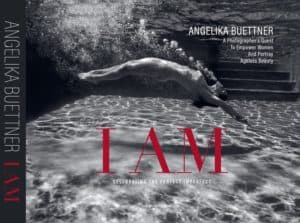Posts Tagged ‘books’
Rekindling Desire (3rd Ed.) by Barry and Emily McCarthy
Rekindling Desire (3rd Ed.)
by Barry and Emily McCarthy
Reviewed by Mac Marshall, PhD
“The most disruptive sexual problem is low desire.”
Do you find that you have little desire for sex with your partner? As a couple do you have sex only a few times a year, if at all? Does one of you want more sex than the other, resulting in arguments, recrimination, blame, and hurt feelings? Are you convinced that your “sex light” has gone out? Do you wonder how to bring back intimacy in a marriage? To rekindle desire is to revitalize, reawaken, and reignite it, and that is the focus of Rekindling Desire (3rd Ed.) by Barry and Emily McCarthy. Their motivation for writing this book is to provide “new insights, support, and hope for couples facing desire problems, a no sex or low sex relationship, and desire discrepancy.”
In our youth and young adulthood, most of us experience spontaneous desire, driven by our hormones. Typically as we age, the hormonally triggered desire for sex becomes less pressing. Many people begin to feel less sexy, less desirous, in and beyond their 40s. That doesn’t have to be the end of sex! We can revivify the relationship by understanding “responsive desire.” Learning to give each other sensual pleasure, including plenty of touching, will stimulate responsive desire for sex in both partners.
Rekindling Desire will be of particular help to those in low-desire relationships, or to couples where there is a discrepancy in desire, with one person pursuing sexual connection while the other distances. It offers thorough explanations of what sex therapists have found to be effective for resolving sexual problems and dysfunction resulting from low desire.
This 247-page book is organized into three parts: Awareness (5 chapters), Change (6 chapters), and Relapse Prevention (4 chapters):
- When and Why Couples Lose Sexual Desire. “Desire problems can occur among all types of couples and all age groups.”
- Whose Problem Is It? Hers, His, or Ours? “Sexual desire and desire problems are best understood as a couple issue.”
- Turnoffs: Poisons for Sexual Desire. “A myriad of psychological, bio-medical, and social/relational factors can poison desire.”
- Finding Your Voice: Celebrating Female Sexuality. “The biggest mistake people make is to define female sexuality narrowly. Sex does not equal intercourse. Sexual satisfaction does not equal orgasm.”
- The New Male Sexuality: Confronting Autonomous Sex Performance. “For the great majority of males…sexual dysfunction causes low desire. The main male sexual dysfunctions are premature ejaculation (PE), erectile dysfunction (ED), and ejaculatory inhibition.”
- Being an Intimate Sexual Team: Discovering Your Couple Sexual Style. “Your couple sexual style has two dimensions: first, how to balance each person’s sexual autonomy (“sexual voice”) with being an intimate sexual team; second, how each couple sexual style integrates intimacy and eroticism.”
- Building Anticipation: Bridges to Sexual Desire. “The prescription for sexual desire is positive anticipation, an emotionally intimate relationship, nondemand pleasuring, erotic scenarios and techniques, sharing orgasm, feeling emotionally bonded and satisfied, and maintaining a regular rhythm of sexual contact.”
- Attachment: Enhancing Intimacy. “The essence of intimacy is feeling emotionally open, securely attached, and personally valued.”
- Nondemand Pleasuring: Let’s Play Touchy-Feely. “Pleasuring includes affectionate, sensual, and playful touch, both inside and outside the bedroom.”
- Challenging Inhibitions and Avoidance: Be Sexually Present. “It is both an individual and couple task to increase awareness and challenge inhibitions.”
- Creating Erotic Scenarios: Vital Sexuality. “The essence of eroticism is scenarios and techniques that increase anticipation, subjective and objective arousal, and erotic flow. This includes, but is not limited to, intercourse.”
- Maintaining Gains: Keeping Sexuality Vital and Satisfying. “The core of relapse prevention is awareness that intimacy and sexuality need continual time and energy.”
- Intimate Attachment: Enhancing Your Bond. “Intimacy dates are a powerful resource for preventing relapse and reinforcing relational satisfaction.”
- The Erotic Marriage: Lusting for Life. “You need to challenge routine and mechanical sex, which is a death knell for desire. Eroticism….must be actively cultivated.”
- Valuing a Satisfying, Secure, and Sexual Relationship. “Commit to maintaining a vital sexual bond. Try to go no longer than 2 weeks without some kind of sexual contact. Sex cannot be taken for granted or treated with benign neglect.”

Each chapter is packed with information and also includes a case study, an exercise, a summary, and key points. This is a book you’ll want to study, not read quickly.
In Barry and Emily McCarthy’s view, rekindling desire relies heavily on a couple’s ability to engage in frank, clear, nonjudgmental communication. They see their book as an adjunct to therapy for those who wish to reawaken intimacy and passion in their relationship. “This is a book of ideas, guidelines, and exercises, not a ‘do it yourself’ therapy book,” they state. “It is not a substitute for sex, couple, or individual therapy.”
Barry McCarthy, PhD is a professor of psychology at American University, a diplomate in clinical psychology, a diplomate in sex therapy, and a certified couple therapist. He is the author of over 100 articles, 33 book chapters and 21 books. He has presented over 450 professional workshops nationally and internationally. He received the SSTAR Masters and Johnson award for lifetime contributions to the sex therapy field.
certified couple therapist. He is the author of over 100 articles, 33 book chapters and 21 books. He has presented over 450 professional workshops nationally and internationally. He received the SSTAR Masters and Johnson award for lifetime contributions to the sex therapy field.
Emily McCarthy received a B.S. degree in speech communication, and her writing and wisdom provides a balanced humanistic perspective. This is Barry and Emily’s 14th co-authored book. They have been married for 52 years.
Purchase Rekindling Desire (3rd Ed.)
================

Mac Marshall, PhD is a retired anthropology professor, researcher, and author who is delighted to explore sexuality studies at this time of his life.
Love in the Time of Corona by Diana Wiley
Reviewed by Mac Marshall, PhD

Echoing the title of Gabriel Garcia Marquez’s novel, Love in the Time of Cholera, Diana Wiley, PhD wrote Love in the Time of Corona during the early months of 2020 as a “guide to redeem, refresh, and renew your relationship while in quarantine.” She is a marriage and family therapist and sex therapist now in her 70s. Given the stresses of the COVID-19 pandemic, Wiley’s main message is that “enjoyable sexual activity between partners can distinctly benefit a couple’s mental and physical health.”
The information in Love in the Time of Corona is relevant for couples of any age, and especially helpful to seniors who are more likely than younger adults to have been in a year-long lockdown.
Wiley’s book is 144 pages of larger-than-usual type for easy reading. It is organized into ten chapters covering these topics:
- Communication. “While you are adapting to each other’s personal habits during quarantine, you could also use this unusual time as an opportunity to learn more useful information about your partner.”
- Planning for Sex Dates. Have and express clear intentions, and then “Take time to communicate and agree on what each of you wants from your date night at home. And then set the date.”
- Mindfulness About Sex. “Entering a mindful state during lovemaking can help you be more present in the moment so you can fully surrender to sexual ecstasy. It helps you get out of your head and into your body.”
- The Importance of Touch. “How you touch your partner (and how your partner touches you) can sometimes be tricky to navigate, even under the best of circumstances. But when you are’ locked down’ together, as during the COVID-19 pandemic, the stakes can be higher because of the increased stress and anxiety inherent in the situation.”
- Suggestions for Sensory Revitalization. Limit screen viewing, get outdoors often, learn a new skill, and regulate your consumption of news. Enjoy food and music, pamper your body, and explore different kinds of kissing. “Having good sex is such a grand, multi sensory experience of intense pleasure” that no one “should be ashamed to claim this biological heritage.”
- The Need for Laughter and Playfulness. “Humor, and the playful spirit that often accompanies it, has detoxifying and defusing effects that go a long way toward keeping relationships intact.” Wiley observes that “couples who laugh together last together.”
- The Significance of Novelty. “Novelty offers a myriad of benefits in addition to increased sexual charge. Researchers have discovered that the desire to have new experiences…is positively associated with much of what helps us thrive in the world.”
- Learning More About Sex. “Did you know that people who have more sexual knowledge are more confident in their sexual conduct?” This chapter recommends a variety of books, instructional videos, podcasts, and interactive online courses.
- Expressing Gratitude to Each Other. Minimize criticism. Manage your frustrations. Express thankfulness more often: “It’s an easy, simple, and surprisingly effective survival strategy for your relationship during this time in quarantine.”
- Recommit to Your Relationship. “This pandemic can serve as an excellent opportunity to
 reexamine and clarify your values. Sit down with your partner and share your hopes and dreams.”
reexamine and clarify your values. Sit down with your partner and share your hopes and dreams.”
Wiley’s writing style is engaging and conversational. Her suggestions will help you engage more fully with your partner. You’ll come away convinced (or reminded) of the central importance of sexual pleasure for strong, happy human relationships.
Learn more about Diana Wiley:
- Dear Dr. Diana: A Sex Therapist’s Advice for Couples in Quarantine
- Dr. Diana Wiley: Licensed Marriage & Family Therapist, Board Certified Sex Therapist
- Purchase Love in the Time of Corona
==============
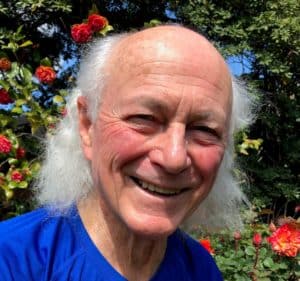
Mac Marshall, PhD is a retired anthropology professor, researcher, and author who is delighted to explore sexuality studies at this time of his life.
I AM by Angelika Buettner: celebrating the beauty of aging bodies

“Using my camera to pry deeper into woman’s psyches, I started to photograph timeless beauty, trying to capture what lies beneath the skin, woman’s hidden desires, and hidden conflicts. I am motivated to help women overcome their inhibitions and insecurities about their bodies. I believed if I could persuade enough women to let themselves be photographed naked, I could prove to them and prove to the whole world, ageless beauty does exist. Women over 40 and 50 and 60 and even women in their 80’s and 90’s radiate from within and are beautiful at every age.”
— Angelika Buettner
I AM is a book of nude photographs of 121 women between the ages of 40 and 100, and it’s so much more. Photographer Angelika Buettner celebrates these women — their beauty, wisdom, humor, and audacity. From the first page, this book shines with a celebration of women’s beauty as they age. No makeovers, no retouching: these are women celebrating their time of life — their authenticity, self-acceptance, and joy. I AM kicks at our outdated notion that we age out of beauty and desirability. Quite the contrary, as Angelika Buettner and her 121 brave women illustrate.
Buettner celebrates these women — their beauty, wisdom, humor, and audacity. From the first page, this book shines with a celebration of women’s beauty as they age. No makeovers, no retouching: these are women celebrating their time of life — their authenticity, self-acceptance, and joy. I AM kicks at our outdated notion that we age out of beauty and desirability. Quite the contrary, as Angelika Buettner and her 121 brave women illustrate.
Each page of photographs glows with images of the splendor of aging. The women proudly bare their wrinkles and loose skin; their large breasts, small breasts, breasts  that droop, or maybe no breasts at all. But the point is that they are at home in their bodies, proud and courageous in their skin. What a lesson we can learn from them!
that droop, or maybe no breasts at all. But the point is that they are at home in their bodies, proud and courageous in their skin. What a lesson we can learn from them!
Buettner explains her mission:
It’s been my passion, my intuition, my vision, my desire, my obsession, and my quest to reveal and showcase ageless beauty of women over 40 to make us all more visible. Using my camera as a therapeutic tool and instrument of social commentary, I have attempted to capture, something raw and refined, edgy and elegant, honest and pure. Naked portraits of strong women who dare to step out of their comfort zone…
We, meaning, the women over 40, who are ready to own their sensuality without being sexualized, stand naked and bare it all. There is no judgement involved in how our bodies look when we see into each other’s souls. We accept we are all goddesses.
We are so much more than our bodies.
We can celebrate our pasts, nourish our present selves and relish what our futures will hold.
In Buettner’s words, “Each picture has a story to be told.” Lucky for us, we get glimpses of those stories. Each woman speaks in prose or poetry about what “I AM” means to her personally. For example, this from Ruth, age 100:
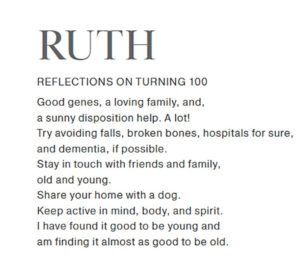
There is great power in this book. If you’re looking for a special Valentine’s gift for a lover or yourself, I urge you to splurge on I AM, a gorgeous book that you’ll be proud to display on your coffee table for all to see. Buettner put 7 years into making this project a reality, and she spared no expense making the finished product stunning — a big book (12″ x 9″ hardcover, weighing 4 pounds) on thick, glossy paper. Purchase it here.
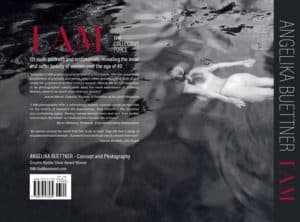
The Joy of Writing about Older Sex (Old Age Sex), guest post by Stella Fosse
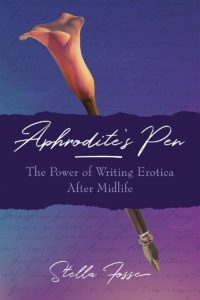
Many assume that erotic writers are young people who write about young characters, but more and more people over 60 are discovering the joy of erotic writing and “old age sex”.
Why? When we write sexy stories, we recapture peak moments in our lives. We can conjure all kinds of sensory details that make the story vivid. Or we can imagine an encounter we never had and bring it to life as a fictional story. We realize our desires in a safe space. Anything is possible on the page!
Erotic writing reminds us that we are sexy at every age. As we play with words, we push back on social assumptions about older people and sex. The very act of creating a story is sexy.
Reading erotica created by others our age is also fun, and a great inspiration for old age sex. Some examples I love:
- Dorothy Freed published her sexual memoir, Perfect Strangers, at age 75.
- Joan Price edited a collection called Ageless Erotica, featuring writers Dorothy’s age and older.
- Free Fall by Rae Padilla Francoeur is a fabulously well written erotic memoir with an older heroine.
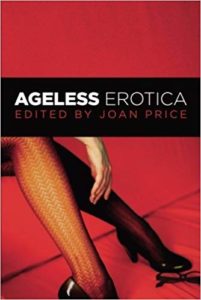
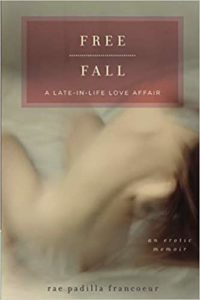

You’ll find more examples on my website, www.stellafosse.com. These books are enjoyable, and you can even use favorite sentences from their stories as writing prompts for yours.
If you experiment with erotic writing — and please do! — it is important to keep a playful and relaxed attitude about what you write. Even for longtime authors, first drafts are just a place to try things out. So pat yourself on the back for being brave, and write without judging.
Now let’s give it a try!
Recall an especially sexy experience in your life. It could have happened yesterday or twenty years ago. Remember it with all your senses:
- What was the other person’s aroma?
- How did it feel to touch them and for them to touch you?
- What did you say to one another, and what other sounds did you make?
- What did you especially love about the other person’s appearance?
- What about the circumstances: What was going on in your lives that made this moment memorable?
On your first writing day, take just ten minutes and begin to write what you remember. If some aspect of the experience eludes you, feel free to make it up as you go.
The next day, write for ten more minutes about that experience. If you keep writing for ten minutes each day, soon you will have a complete draft of an erotic story that you can look back upon and savor.
I hope you will try writing erotica, and that it brings you much joy.
—–

– Stella Fosse is an erotica writer, the author of Aphrodite’s Pen: The Power of Writing Erotica after Midlife, and a late bloomer whose erotic life blossomed in her late 50s. Access a free story writing course from Stella here.

